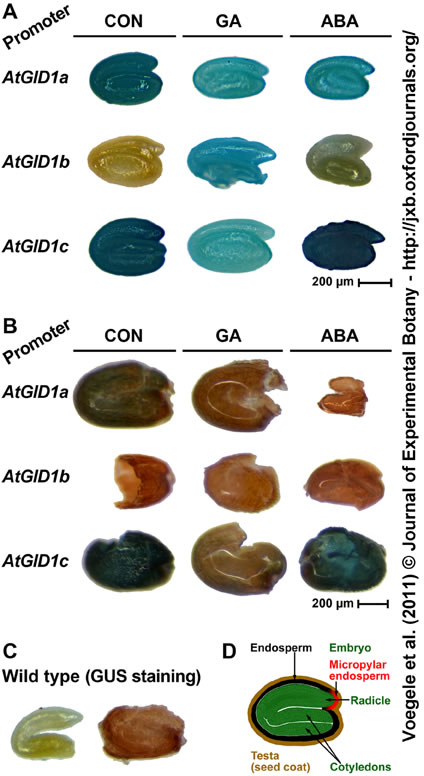Journal of Experimental Botany 62: 5131–5147 (2011)
|
Members of the gibberellin receptor gene family GID1 (GIBBERELLIN INSENSITIVE DWARF1) play distinct roles during Lepidium sativum and Arabidopsis thaliana seed germination [W][OA]
|
Antje Voegele, Ada Linkies, Kerstin Müller*, Gerhard Leubner-Metzger
|
University of Freiburg, Faculty of Biology, Institute for Biology II, Botany / Plant Physiology, Schänzlestr. 1, D-79104 Freiburg, Germany, Web: 'The Seed Biology Place' http://www.seedbiology.de
*Department of Biological Sciences, Simon Fraser University, 9 8888, University Drive, Burnaby BC, V5A 1S6, Canada
Received 14 March 2011; Revised 22 May 2011; Accepted 13 June 2011
Advance Acess publication 21 June 2011
DOI 10.1093/jxb/err214
|
 |
 |
Fig. 3. Histochemical analysis of gene promoter activities in of the three Arabidopsis thaliana GID1 genes during seed germination.
Seeds of GUS reporter lines in which the three GID1 gene promoters, AtGID1a, AtGID1b, and AtGID1c control the transgene transcription were imbibed in medium without (CON) or with 10 µM GA4+7 (GA) or 5 µM ABA added. After seed dissection into embryo and 'coat' (testa plus endosperm) at 20 h, histochemical GUS analysis was performed.
A, Histochemical GUS analysis of isolated embryos from GID1 reporter gene seeds.
B, Histochemical GUS analysis of isolated 'coats' from GID1 reporter gene seeds. C, Negative control for the histochemical GUS staining with isolated wild-type embryo and 'coat'. D, Cross-section of A. thaliana seed indicating the specific seed tissues analysed used in the experiment.
|
|
|
|
|
